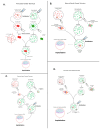Causes of and Solutions to Mitochondrial Disorders: A Literature Review
- PMID: 40724895
- PMCID: PMC12294821
- DOI: 10.3390/ijms26146645
Causes of and Solutions to Mitochondrial Disorders: A Literature Review
Abstract
Mitochondria are currently of great interest to scientists. The role of mitochondrial DNA (mtDNA) mutations has been proven in the genesis of more than 200 pathologies, which are called mitochondrial disorders. Therefore, the study of mitochondria and mitochondrial DNA is of great interest not only for understanding cell biology but also for the treatment and prevention of many mitochondria-related pathologies. There are two main trends of mitochondrial therapy: mitochondrial replacement therapy (MRT) and mitochondrial transplantation therapy (MTT). Also, there are two main categories of MRT based on the source of mitochondria. The heterologous approach includes the following methods: pronuclear transfer technique (PNT), maternal spindle transfer (MST), Polar body genome transfer (PBT) and germinal vesicle transfer (GVT). An alternative approach is the autologous method. One promising autologous technique was the autologous germline mitochondrial energy transfer (AUGMENT), which involved isolating oogonial precursor cells from the patient, extracting their mitochondria, and then injecting them during ICSI. Transmission of defective mtDNA to the next generation can also be prevented by using these approaches. The development of a healthy child, free from genetic disorders, and the prevention of the occurrence of lethal mitochondrial disorders are the main tasks of this method. However, a number of moral, social, and cultural objections have restricted its exploration, since humanity first encountered the appearance of a three-parent baby. Therefore, this review summarizes the causes of mitochondrial diseases, the various methods involved in MRT and the results of their application. In addition, a new technology, mitochondrial transplantation therapy (MTT), is currently being actively studied. MTT is an innovative approach that involves the introduction of healthy mitochondria into damaged tissues, leading to the replacement of defective mitochondria and the restoration of their function. This technology is being actively studied in animals, but there are also reports of its use in humans. A bibliographic review in PubMed and Web of Science databases and a search for relevant clinical trials and news articles were performed. A total of 81 publications were selected for analysis. Methods of MRT procedures were reviewed, their risks described, and the results of their use presented. Results of animal studies of the MTT procedure and attempts to apply this therapy in humans were reviewed. MRT is an effective way to minimize the risk of transmission of mtDNA-related diseases, but it does not eliminate it completely. There is a need for global legal regulation of MRT. MTT is a new and promising method of treating damaged tissues by injecting the body's own mitochondria. The considered methods are extremely good in theory, but their clinical application in humans and the success of such therapy remain a question for further study.
Keywords: mitochondrial DNA; mitochondrial disorders; mitochondrial replacement therapy; mitochondrial transplantation therapy; review; three-parent baby.
Conflict of interest statement
The authors declare no conflicts of interest.
Figures




References
-
- Kang E., Wu J., Gutierrez N.M., Koski A., Tippner-Hedges R., Agaronyan K., Platero-Luengo A., Martinez-Redondo P., Ma H., Lee Y., et al. Mitochondrial replacement in human oocytes carrying pathogenic mitochondrial DNA mutations. Nature. 2016;540:270–275. doi: 10.1038/nature20592. Erratum in: Nature 2019, 567, E5–E9. - DOI - PubMed
Publication types
MeSH terms
Substances
LinkOut - more resources
Full Text Sources
Medical

